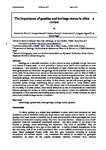The Importance of Geosites and Heritage Stones in Cities—a Review
| dc.contributor.author | De Wever, P | |
| dc.contributor.author | Baudin, F | |
| dc.contributor.author | Pereira, D | |
| dc.contributor.author | Cornée, A | |
| dc.contributor.author | Egoroff, G | |
| dc.contributor.author | Page, K | |
| dc.date.accessioned | 2017-01-24T14:20:43Z | |
| dc.date.issued | 2016-12-30 | |
| dc.identifier.issn | 1867-2477 | |
| dc.identifier.issn | 1867-2485 | |
| dc.identifier.uri | http://hdl.handle.net/10026.1/8308 | |
| dc.description.abstract |
Geology, as a scientific discipline, is often viewed as most applicable in high mountains or in deserts or coastal areas—or more generally in ‘natural areas’ where rock exposures are most conspicuous—and, therefore, not to be experienced by most visitors and tourists. In contrast, most geoscientists are convinced that geology can be practised on an everyday basis, as it is part of our daily life as a facet of the natural environment that humans have used for 100 s of thousands of years. Even in places where the natural world seems far from its original condition, one can still experience geology. This consideration is of increasing importance, as today, more than half the world’s population lives in towns and cities. In this context, we can still present geology to an interested public through establishing leisure walks, either guiding or using leaflets, easily carried booklets and even web ‘apps’. The style chosen aims to be accessible to a broader public, but crucially, in an urban context, there should always be an aim to demonstrate the relationship between geology and society, as well as architecture and history. Indeed, the realisation of many participants in such activities that building stones can belong to, and provide evidence of, both a natural and a built heritage can be a revelation. | |
| dc.format.extent | 561-575 | |
| dc.language | en | |
| dc.language.iso | en | |
| dc.publisher | Springer Science and Business Media LLC | |
| dc.subject | 37 Earth Sciences | |
| dc.subject | 3709 Physical Geography and Environmental Geoscience | |
| dc.subject | 3705 Geology | |
| dc.subject | Generic health relevance | |
| dc.title | The Importance of Geosites and Heritage Stones in Cities—a Review | |
| dc.type | journal-article | |
| dc.type | Journal Article | |
| plymouth.issue | 4 | |
| plymouth.volume | 9 | |
| plymouth.publication-status | Published online | |
| plymouth.journal | Geoheritage | |
| dc.identifier.doi | 10.1007/s12371-016-0210-3 | |
| plymouth.organisational-group | /Plymouth | |
| plymouth.organisational-group | /Plymouth/Faculty of Science and Engineering | |
| plymouth.organisational-group | /Plymouth/REF 2021 Researchers by UoA | |
| plymouth.organisational-group | /Plymouth/REF 2021 Researchers by UoA/UoA07 Earth Systems and Environmental Sciences | |
| dcterms.dateAccepted | 2016-12-08 | |
| dc.rights.embargodate | 2017-12-30 | |
| dc.identifier.eissn | 1867-2485 | |
| dc.rights.embargoperiod | Not known | |
| rioxxterms.versionofrecord | 10.1007/s12371-016-0210-3 | |
| rioxxterms.licenseref.uri | http://www.rioxx.net/licenses/all-rights-reserved | |
| rioxxterms.licenseref.startdate | 2016-12-30 | |
| rioxxterms.type | Journal Article/Review |


